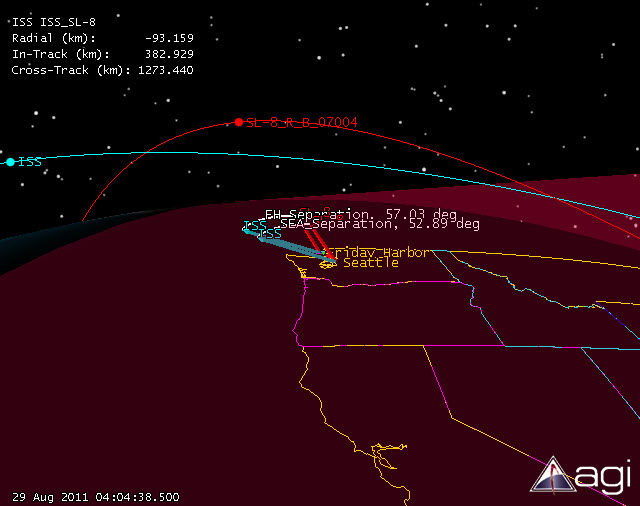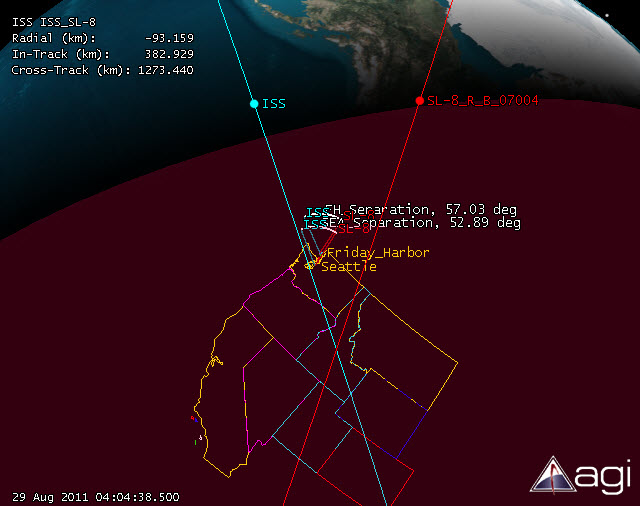I wanted to revisit the previous post, describing a near miss of ISS I witnessed back in August. Recall that both my brother and I saw the same 2 satellites cross in the sky at the same time.
First, let’s just take a look at the geometry that allows satellites to be seen in the first place. If you’re going to see a satellite from the ground, it needs to be lit (by the sun) and you need to be in shadow (night). Here’s a picture of the geometry from my location on Aug. 29, 2011.
The red cylinder off to the right is the shadow, the Sun is off to the left. A little closer look allows us to see what’s happening. The two satellites (ISS in the blue, SL rocket body in the red) have orbits that are above the shadow. Note that Friday Harbor and Seattle are both in darkness.
Also note that while the 2 vehicles are thousands of km apart, they are separated by 57 deg in Friday Harbor, and 52 degrees in Seattle. My brother and I were watching them approach rapidly, but we were not seeing exactly the same thing. Here’s the same view from above:
Notice how the separation angles between the two object converge when they cross. This shows what Astrogator_John knew, i.e. that when my brother and I both saw negligible separation, they must have been really close. I emailed several friends at the Center for Space Standards and Innovation in Colorado Springs. I asked them about this sort of close approach, and how they would expect NASA to deal with it.
NASA considers an object to be “close” only if it will pass inside a rectangular shaped “Box” region around the station, measuring 0.75 kilometers above and below the station and 25 kilometers on each side.
Sal Alfano: “It is quite possible that the SP [Special Perturbations, the DoD higher precision orbital elements] showed a conjunction within the ISS box, but the resulting probability was low enough to mitigate any collision concerns.”
Thus, you may be able to have close approaches inside the normal “box” that would normally trigger a maneuver, if both objects have very well known ephemerides. This makes sense for both of these objects. Obviously ISS is constantly tracked, and a rocket body launched in the 1970s should also have a well-understood orbit.
Finally, I contacted (indirectly) ISS trajectory Ops lead Lark Howorth. He said: “That [the blog posting] is very impressive work ….The total miss distance was actually 2.0 km. We were aware of the pass and had plenty of time to work it. Because of the geometry (a radial miss distance of just over 1 km), we were able to compute the collision probability to be virtually zero.”
There is a lot more to what Lark says here. NASA works closely with the Joint Space Operations Center (JSpOC) to track objects and predict close approaches. Without going into details, let’s just say that there are personalities and turf battles and all the other fun stuff that goes on when government agencies get involved. For a not-so-short description of how that all works, I recommend : an excellent piece by Brian Weeden on The Space Review.
Conclusion
While it was cool to witness a close approach, it was also quite unnerving. I couldn’t help but think what it would have looked like if the rocket body had hit ISS. I’m happy it didn’t happen, sometimes a little bit of knowledge can be scary.
I leave you with this quote from Sal:
“I just hope that for future conjunctions their high confidence in the accuracy of the radial component is not misplaced.”


